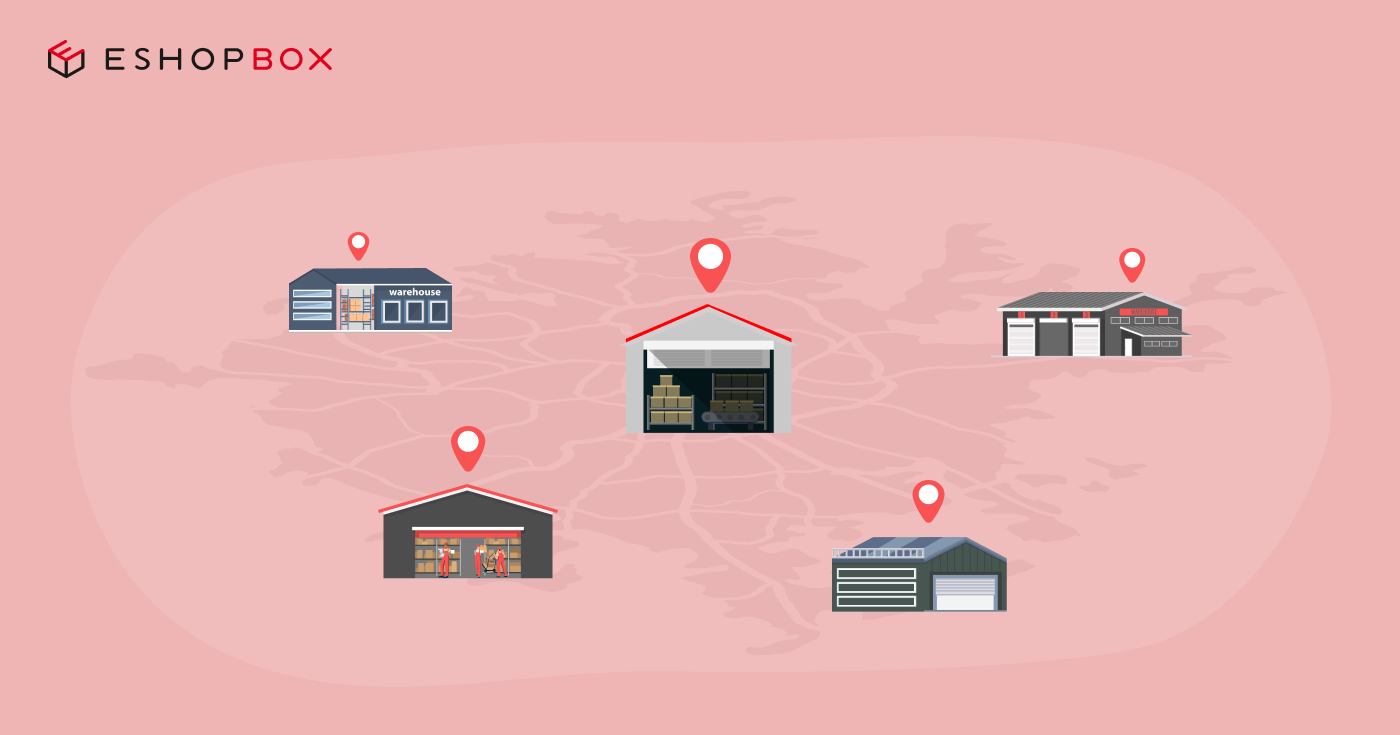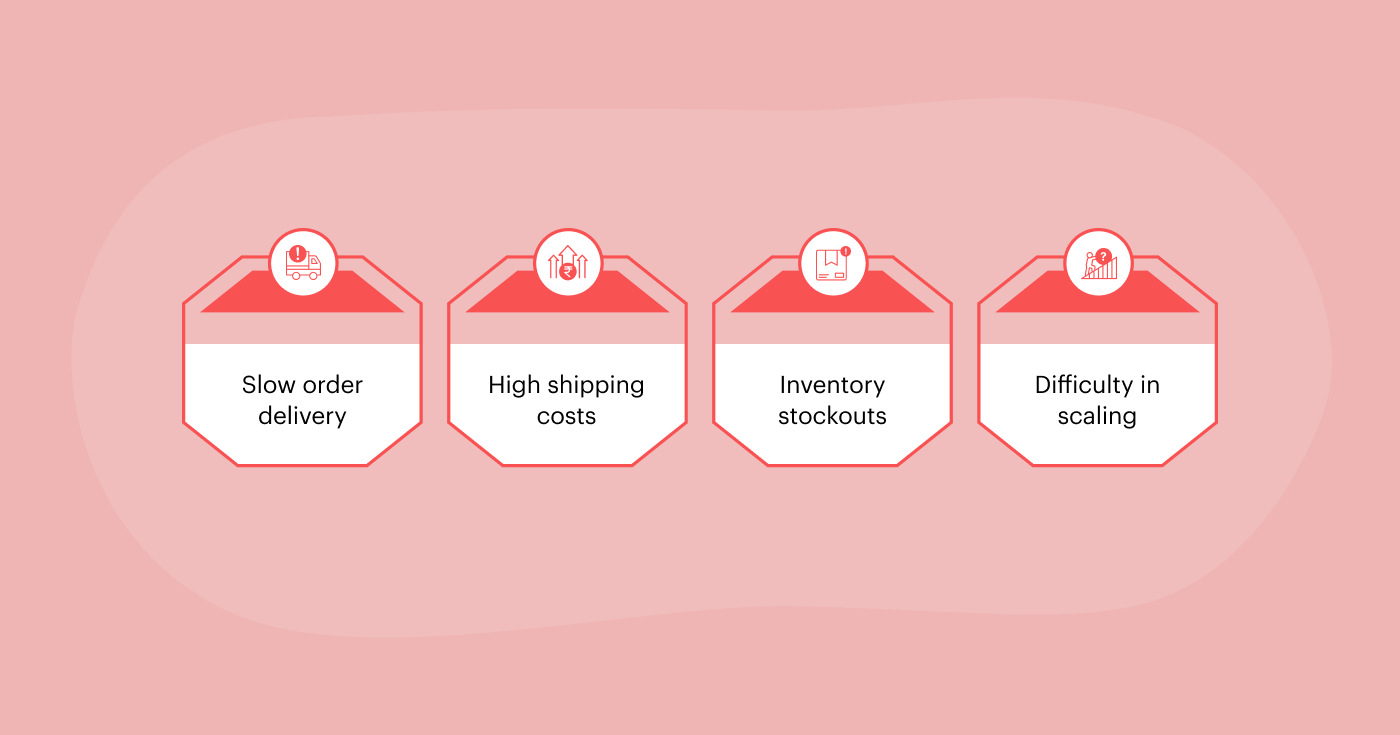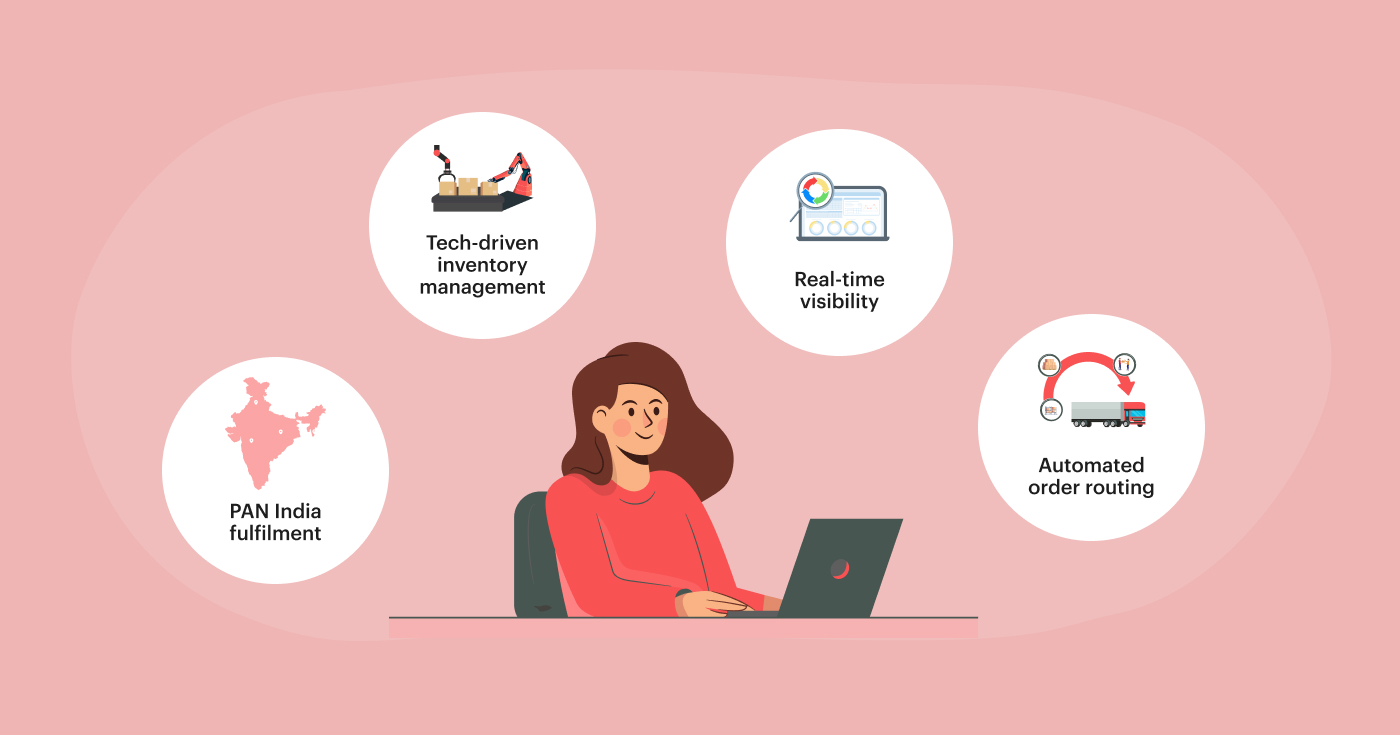
Get the latest from
Eshopbox

Customers now expect speed as standard. Same-day dispatch, next-day delivery, and a hassle-free fulfilment experience aren’t nice-to-haves anymore—they’re the baseline.
But many ecommerce brands are still relying on a single, centralised warehouse. This often means shipping orders across long distances, leading to higher costs, slower delivery times, and frustrated customers. As competition heats up and customer expectations rise, this gap in fulfilment can quickly become a growth bottleneck.
The smartest way to overcome these challenges is multi-location warehousing. By storing inventory across multiple fulfilment centres, closer to where your customers are, you cut delivery times, reduce costs, and improve the overall shopping experience. It’s a fulfilment strategy that’s helping brands scale faster and stay competitive.
What is multi-location warehousing?
Multi-location warehousing is a fulfilment strategy where your inventory is distributed across multiple warehouses or fulfilment centres in different regions. Instead of storing all your products in one central location, you position stock closer to your customers. The result: faster deliveries, lower logistics costs, and a smoother shopping experience.
Think of it as building a connected network of fulfilment hubs. Each hub isn’t a copy of the other—it carries the right SKUs in the right quantities based on local demand, seasonal trends, and customer proximity. For example, a brand might use a fulfilment centre in Bangalore to serve South Indian customers faster, while a partner in Gurgaon could handle North Indian demand. Winter wear can be stocked more heavily in northern regions, while fast-moving everyday essentials are balanced nationwide.
This approach ensures your brand isn’t just reacting to customer orders—it’s anticipating them. By aligning inventory with buying behaviour, you improve service levels, reduce the risk of stockouts, and create the kind of delivery experience that keeps customers coming back.
Why multi-location warehousing is crucial for ecommerce success?
Multi-location warehousing isn’t just another logistics buzzword—it’s quickly becoming a must-have for ecommerce brands that want to stay competitive. Here’s why:
Customers expect speed everywhere. Marketplaces and large players like Amazon have raised the bar. Shoppers now expect their orders to reach them quickly no matter where they live. When a customer needs to find a warehouse near me, they're signaling an expectation for local, fast fulfilment. A single-warehouse setup simply can’t match the speed and consistency that distributed inventory makes possible.
Expanding into new markets becomes easier. When you add fulfilment centres in new regions, you don’t just cut delivery times—you also build a stronger local presence. Establishing a presence with a reliable warehouse in Mumbai, for example, can be pivotal for capturing the western market, just as a warehouse in Hyderabad serves the growing demand in Telangana and surrounding states.
Operations become more resilient. With multiple locations, your business isn’t tied to one facility. If one fulfilment centre faces delays or disruptions, another can step in—keeping orders moving and customers happy.
What are the common challenges with single-warehouse operations?

For a young ecommerce brand, a single warehouse feels like the simplest way to run fulfilment—one location, one team, one stock pool. But as your customer base expands and order volumes rise, this centralised approach starts creating bottlenecks. The result is slower growth, higher costs, and customer experiences that fall short of expectations.
1. Slow delivery to distant customers
When every order leaves from one location, delivery times depend on how close the customer is to that warehouse. Someone in the same city might get their order the next day, while customers in other states wait three to five days, sometimes longer. A customer in Pune waiting for a shipment from a single warehouse will face significantly longer delays than if the brand had a warehouse in Mumbai to serve the region.
This gap in delivery speed creates serious consequences. Customers increasingly factor delivery timelines into their buying decisions—if they see your competitor can ship in two days while you take five, you lose the order. On marketplaces, products with slower shipping are ranked lower in search results, costing you visibility and sales. On your D2C site, repeat purchases suffer, because shoppers don’t want to wait when faster alternatives are available. What looks like a manageable delay on paper quickly becomes a barrier to growth in entire regions.
2. High shipping costs
Distance drives cost in logistics. A single-warehouse setup means shipping long-haul for every customer outside your immediate region. Over time, these high freight costs drain profitability, especially on low- to mid-value products where delivery eats up a big share of revenue.
This forces tough trade-offs. Absorbing the cost cuts into your margins, while passing it on makes you less competitive. Free shipping becomes unsustainable, and even modest shipping fees cause cart abandonment. Meanwhile, brands that operate multiple locations can ensure there's always a warehouse near me from the customer's perspective, offering faster delivery at a lower cost and winning price-sensitive shoppers. For scaling businesses, this imbalance becomes a constant drag on profitability.
3. Inventory stockouts and overstocks
Centralising inventory treats demand as though it’s the same everywhere—but it isn’t. A bestseller in North India might move slowly in the South, while seasonal products peak in one region and stagnate in another. With one warehouse, it’s almost impossible to balance stock against these variations. A product flying off the shelves in Hyderabad might be sitting idle if all your stock is concentrated elsewhere.
The impact is twofold. Stockouts on high-demand items lead to missed orders, frustrated customers, and lower marketplace ratings. At the same time, overstocked items occupy warehouse space and tie up working capital, hurting your cash flow. You end up with money locked in the wrong products, and customers unable to buy the right ones. For brands chasing growth, this mismatch between supply and demand creates both financial and reputational losses.
4. Difficulty scaling during demand surges
Festive seasons, flash sales, or viral social media moments can multiply order volumes overnight. A single warehouse has finite labour, packing lines, and dispatch capacity. When it’s stretched beyond its limits, orders pile up.
The fallout is painful. Dispatch delays lead to missed delivery promises, higher cancellation rates, and a spike in customer complaints. For marketplaces, that means penalties, reduced visibility, and a damaged seller rating. For your D2C store, it means lost trust—shoppers are far less likely to buy again if their first experience was delayed or mishandled. Worst of all, the negative impression lasts long after the surge is over, eroding the long-term value of new customer acquisition.
How multi-location warehousing transforms ecommerce operations?
Adopting a multi-location warehousing strategy directly solves the pain points of a single-warehouse model while opening up new opportunities for growth. By positioning inventory closer to customers, brands can meet rising expectations, control costs, and build resilience into their fulfilment operations.
1. Faster shipping through strategic proximity
When products are stored across multiple fulfilment centres, orders are shipped from the one closest to the customer. This drastically reduces transit times. A customer in Bangalore who receives an order from a local fulfilment centre experiences one- or two-day delivery instead of waiting four to five days for a package shipped from another region.
This consistency in delivery speed drives higher conversions and customer satisfaction. On marketplaces, faster delivery improves search rankings. On D2C stores, it strengthens loyalty—because shoppers are far more likely to return when they’ve had a reliable, speedy delivery experience.
2. Lower delivery costs
Shorter shipping distances don’t just save time—they save money. Delivering an order across 100 km costs significantly less than shipping across 1,000 km. With a distributed network, the majority of orders travel shorter routes, reducing per-order logistics costs at scale.
These savings create real competitive advantages. Brands can reinvest the margin back into marketing, product development, or customer acquisition. They can also absorb the cost to maintain free shipping or pass savings on to customers as lower prices—making the brand more competitive in crowded categories.
3. Enhanced stock management flexibility
With multiple fulfilment centres, inventory can be distributed intelligently based on where demand actually exists. Regional buying behaviour, seasonal variations, and even cultural preferences can be accounted for. A warehouse in Gurgaon can be stocked for North Indian demand patterns, while a warehouse in Hyderabad handles the specific needs of the central and southern markets. Similarly, a warehouse in Bangalore is ideal for catering to the southern region's demand. Winter wear can be stocked more deeply in northern India, while southern centres focus on summer apparel or all-weather essentials.
This flexibility reduces both stockouts and overstocks. Customers are more likely to find their preferred product available in their region, while brands avoid locking up capital in slow-moving stock. In the long run, this optimises working capital, reduces storage waste, and improves overall operational efficiency.
"Regional coverage has transformed our ecommerce operations. With Eshopbox's distributed approach, we are now able to deliver orders faster while significantly reducing our logistics costs. The data-driven inventory insights have been invaluable for our business planning."
— Team Portronics
Read the full case study here
4. Reduced risk from disruptions
A single warehouse leaves brands vulnerable—any disruption can bring operations to a halt. Multi-location warehousing spreads that risk. If one fulfilment centre is affected by weather, strikes, technical outages, or overcapacity, others can pick up the slack. If operations are halted at one location, orders can be seamlessly routed from another facility.
For customers, this means continuity of service. For brands, it means fewer cancelled orders, fewer penalties from marketplaces, and protection of hard-earned reputation. In a market where disruptions are inevitable, this built-in resilience is a critical safeguard.
5. Improved service coverage and regional expansion
With multiple fulfilment centres spread across regions, brands can confidently reach new markets without compromising delivery speed. By positioning inventory closer to customer clusters, every shopper experiences faster, more reliable fulfilment—no matter where they’re located.
This wider service coverage fuels business growth. Reliable delivery builds trust with first-time buyers, improves conversion rates at checkout, and increases the likelihood of repeat purchases. At the same time, it gives your brand a local-level presence, helping you compete effectively against players who already operate in those regions.
6. Optimised inventory management
With the right technology, regional sales data can be analysed to continuously optimise inventory placement. Stock is replenished in the right fulfilment centre at the right time, minimising both excess stock and out-of-stock situations.
This leads to healthier cash flow, better utilisation of storage capacity, and more accurate demand forecasting. Instead of reacting to problems, brands proactively manage inventory across regions—making fulfilment a driver of growth rather than a source of inefficiency.
How Eshopbox enables scalable multi-location warehousing

While the value of multi-location warehousing is clear, setting up and managing it yourself can be complex—requiring investment in infrastructure, technology, and people. Eshopbox makes it simple by giving brands immediate access to a distributed network, advanced inventory management, real-time visibility, and automated order routing. Here’s how:
1. Extensive network of fulfilment centres
Eshopbox operates a network of strategically placed fulfilment centres across India's major commercial hubs. Instead of building warehouses from scratch, you plug directly into this infrastructure and scale instantly.
How this helps your brand:
- Store inventory in multiple fulfilment centres near your customer clusters, including key metros like a warehouse in Mumbai for the West, a warehouse in Bangalore for the South, and a warehouse in Gurgaon for the North.
- Rely on standardised infrastructure across all facilities—temperature control, storage systems, and security.
- Benefit from end-to-end management—Eshopbox handles staffing, picking, packing, and dispatch so you don’t need to.
- Gain instant nationwide reach without heavy upfront costs in real estate or operations.
This network becomes the backbone of faster shipping and wider coverage.
2. Technology-driven inventory management
Having multiple warehouses only works if inventory is optimally placed. Eshopbox’s inventory management system makes this possible by combining data intelligence with automation.
How this helps your brand:
- Track inventory levels in real time across all fulfilment centres from a single dashboard.
- Use demand forecasting to predict regional sales and decide how much stock to send to each location.
- Automate replenishment planning so fast-moving SKUs are restocked before they run out.
- Get SKU-level insights into which products perform best in which region, helping you align stock with local demand.
This ensures the right product is always in the right place, reducing stockouts, overstocks, and tied-up capital.
3. Real-time visibility and control
Scaling across multiple fulfilment centres doesn’t mean losing visibility. With Eshopbox, you manage all your distributed operations through one central system.
How this helps your brand:
- Monitor all inventory, orders, and returns across locations from a unified dashboard.
- Track the status of every order in real time—from order placement to final delivery.
- Measure performance with analytics and reports on fulfilment speed, SLA adherence, and inventory turnover.
- Receive proactive alerts on issues like low stock or delayed shipments, so you can act quickly.
You stay in complete control while Eshopbox runs the heavy operations in the background.
4. Automated order routing
With multiple fulfilment centres, routing orders manually is inefficient and error-prone. Eshopbox automates this process to guarantee speed and cost efficiency at scale.
How this helps your brand:
- Automatically route each order to the closest fulfilment centre that has the item in stock.
- Optimise for delivery speed to consistently meet same-day or next-day promises.
- Reduce shipping costs by fulfilling orders from the most cost-effective location.
- Seamlessly handle split shipments when items in one order are stored across different fulfilment centres.
This automation ensures every order is shipped in the fastest, most efficient way—without your team lifting a finger.
How to get started with multi-location warehousing?

Shifting to a multi-location fulfilment model may sound complex, but with the right approach it becomes straightforward and highly rewarding. Here’s a simple roadmap to make the transition smooth:
1. Start with data analysis
The first step is understanding where your customers are and how they buy. Look at your sales history to identify clusters of demand, delivery lanes that currently take too long, and SKUs that move faster in certain regions. This data helps you pinpoint where adding fulfilment centres will have the biggest impact on delivery speed and cost.
2. Begin with high-impact regions
Instead of going nationwide right away, start with a few key regions where fulfilment delays or costs are most challenging. This could mean first placing inventory to serve the tech-savvy customers in Bangalore or the rapidly growing market in Hyderabad. Placing inventory closer to these customers gives you quick wins—faster delivery promises, higher conversions, and lower shipping costs. Once proven, you can gradually expand to additional locations.
3. Partner with an experienced provider
Building and managing your own distributed network requires heavy capital investment and operational expertise. By working with a partner like Eshopbox, you instantly plug into a ready-made fulfilment infrastructure. You get access to multiple fulfilment centres, advanced inventory management, and automated order routing—without having to manage the complexity yourself.
4. Monitor and optimise continuously
Multi-location warehousing isn’t a one-time setup. Customer demand shifts with seasons, trends, and product launches. That’s why continuous monitoring is essential. Track delivery performance, shipping costs, and inventory health across locations. Use these insights to adjust stock distribution, open new regions, or rebalance capacity as your business evolves.
The bottom line: Multi-location warehousing is now essential
Multi-location warehousing has evolved from a nice-to-have advantage to a must-have capability for competitive ecommerce businesses. The combination of improved customer satisfaction, reduced costs, enhanced operational resilience, and expanded growth opportunities makes it an essential strategy for businesses serious about long-term success.
With Eshopbox's established fulfillment network and advanced technology platform, implementing multi-location warehousing becomes straightforward and immediately beneficial. You can focus on growing your business while we handle the complex logistics of distributed inventory management and fulfillment.
Connect with our fulfilment expert today.
Talk to salesRelated Articles
Scaling D2C Success: Why Top Brands Trust Eshopbox as Their Fulfillment Partner
How smart ecommerce fulfilment services help home & lifestyle D2C brands in India?
How Marketplace-Ready Fulfilment Can Increase Conversion by 30%
Get the latest from Eshopbox













